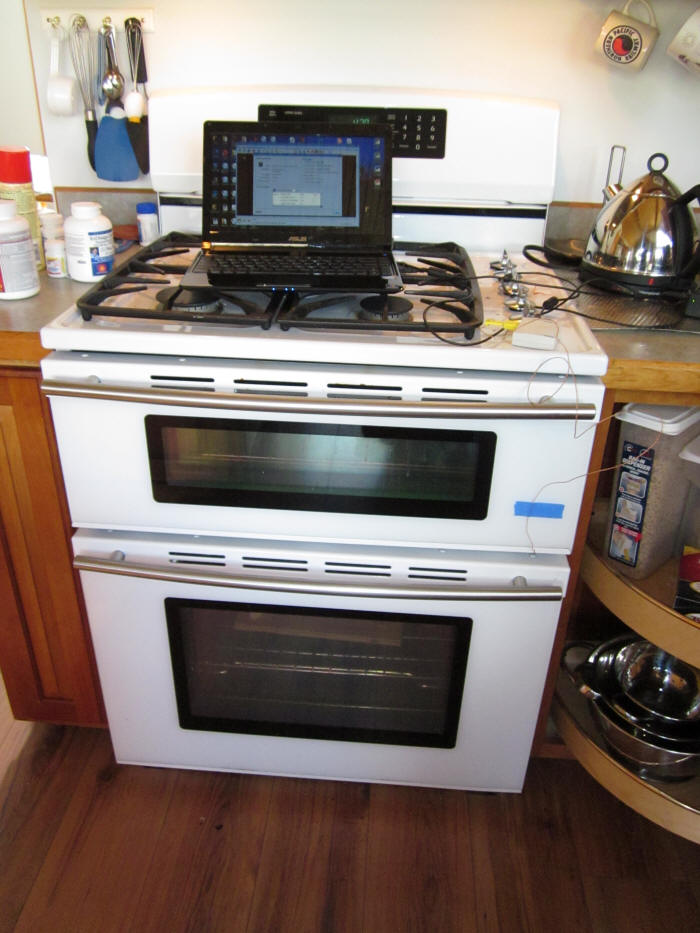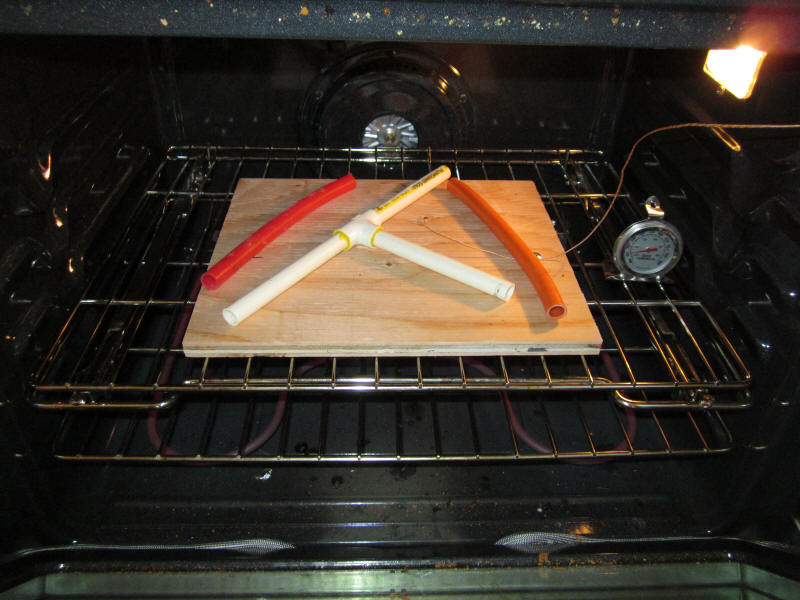
Search
The Renewable Energy site for Do-It-Yourselfers
CPVC, PEX and PEX-AL-PEX in a short
elevated temperature test
|
This is a redo of a test that I did earlier just to see how CPVC
would hold up to short exposure to elevated temperature in a kitchen
oven.
The earlier test was done sloppily -- especially in terms of having
an independent way to measure oven temperatures. It turns out our
oven has very poor temperature regulation, and an independent means to
measure temperatures is a must.
So, while the old test had CPVC showing serious deterioration at
temps as low as 200F, this test with better temperature measurements
shows the CPVC holding is shape to at least 220F, with noticeable
permanent deformation of the CPVC occurring somewhere between 220F and
260F.
I also included samples of regular PEX and Pex-Al-Pex this time.
This test only shows what it shows -- don't read too much into it.
It does not say what a reasonable service temperature limit is for any
of these materials. It just shows how they react to short term
high temperatures in an oven.
I can add that my
Pex-Al-Pex collector performed well over a couple years with
stagnation temperature events on a few occasions in the 230F area.
This was a non-pressurized, drain back collector. When I upgraded
the collector after 2 years, I took a good look at it (including sawing
sections through it), and I could find no signs of problems. The
steep tilt and single glazing of this collector kept stagnation temps to
about 230F, but a shallower tilt or double glazing, or maybe just a
hotter climate would likely have resulted in much higher stagnation
temperatures. If you plan to used any of these materials in a
collector, you must have a plan to limit stagnation temps.
|
|
Test Setup

The test tubes were in the lower (larger oven). The convection oven
setting was used to try to keep a more even temperature.

Samples of regular PEX (red), CPVC (white), and Pex-Al-Pex (orange) were set
out on a piece of half inch plywood so the tubes would not be exposed to direct
radiation from the heating element.
A K type thermocouple was used to measure temperature (its the wire coming in
from the right). The thermocouple was logged on an Onset Computer logger
(see plot below).
I was kind of amazed how awful a job the oven does of keeping an even
temperature -- it was perfectly happy at times for the oven to be 30F lower than
the set temperature. I finally gave up on trying to set a temperature on
the oven, and just manually set the temp well above what I wanted, waited until
the thermocouple said the oven was a bit above what I wanted, and then set a low
temperature and let the oven drift down through the desired temperature range.
At each of the temperatures listed below, I opened the oven door and had a
look at each of the samples, assessed whether they had suffered any deformation,
and then picked them up and tried to bend them with just finger pressure.
The logger plot (below) shows the oven temperature traces for the whole period.
150 F Oven Temp
At 150F, all of the tubes were fine. Essentially no real change from
room temperature.
200 F Oven Temp

At 3:55pm opened oven door and examined the tubes. Oven temperature was
195 F -- having drifted down from about 205 F over the past 5 minutes.
No visible signs of problems or deformation of any of the tubes.
All were noticeably more flexible to finger pressure bending.
220F Oven Temperature

At 4:10 pm opened oven door and examined the tubes. Oven temperature
was 222 F -- having drifted down from about 230 F over the past 5 minutes.
No visible signs of problems or deformation of any of the tubes.
All were even more flexible to finger pressure bending.
260F Oven Temperature
At 4:30pm opened oven door and examined the tubes. Oven temperature was
260 F -- having drifted down from about 268 F over the past 5 minutes.
The CPVC showed some warping in shape for the first time.
All tubes easily bent with light finger pressure.
275F Oven Temperature
At 4:39pm opened oven door and examined the tubes. Oven temperature was
275 F -- the oven temperature had been rising from 250F ish over the past 5
minutes.
The CPVC showed warping, and was very easy to deflect through large angles
with very light finger pressure.
The PEX was still holding its shape, but was very flexible.
The PAP was the stiffest to light finger pressure, but just a bit of finger
pressure put the permanent buckle in the tube shown in the right picture.

Gary April 17, 2012

